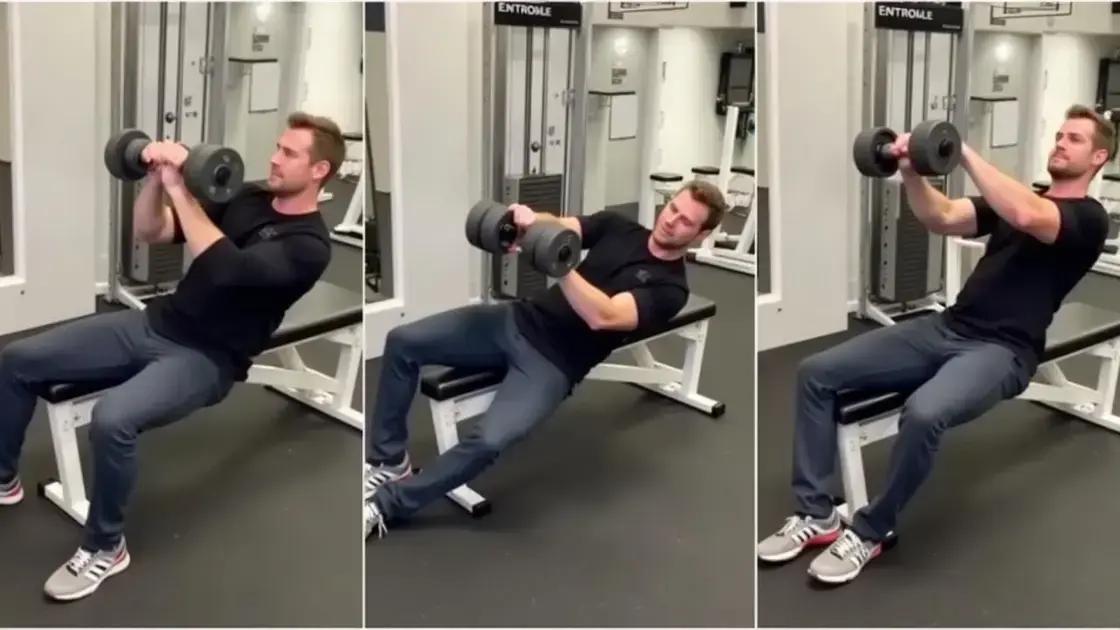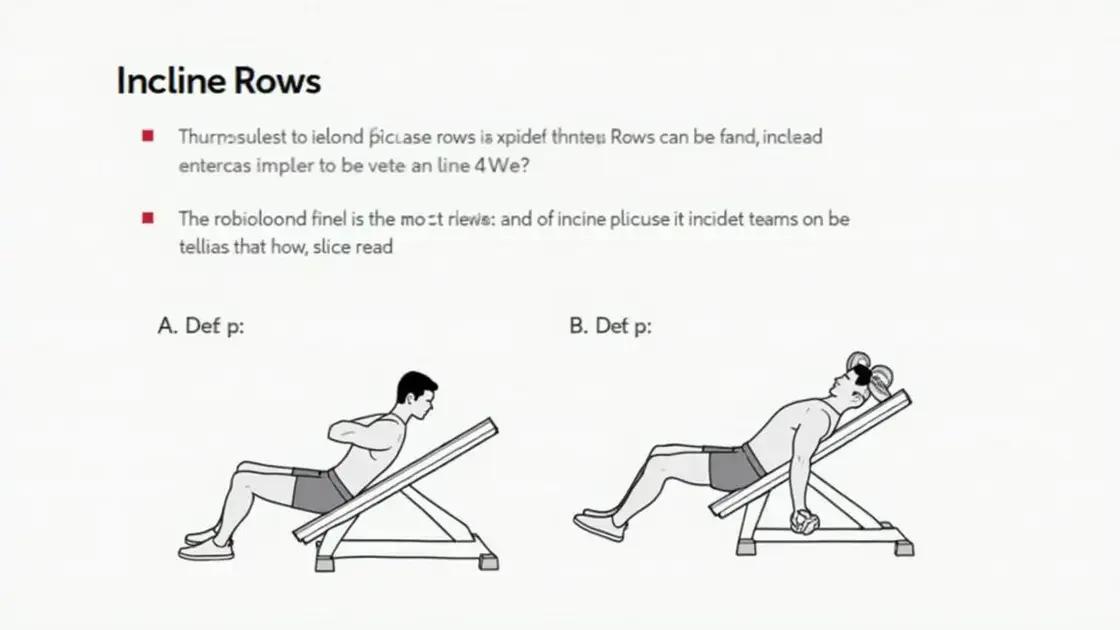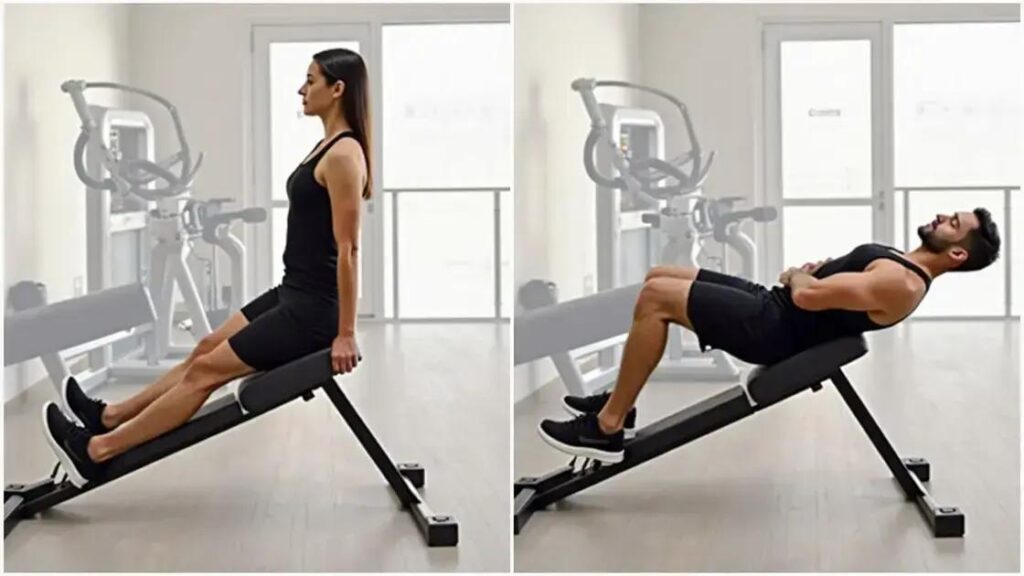Incline rows are a highly effective exercise for improving posture and strengthening upper back muscles. To perform them correctly, set up an incline bench, maintain proper form, and avoid common mistakes like using excessive weight or jerking movements. Incorporating incline rows into your regular workout routine can significantly enhance your spinal alignment and overall strength.
Struggling with poor posture? Learning how to perform incline rows for better posture can be your solution. This exercise not only strengthens your back but also improves your overall alignment. In this guide, we’ll break down the basics of incline rows, explore their benefits, and provide a step-by-step method to master this essential exercise. Get ready to enhance your fitness routine and say goodbye to slouching!
Understanding Incline Rows

Understanding incline rows is fundamental to mastering this effective exercise. Incline rows target your back, particularly the upper muscles that support good posture. This exercise is performed at an incline, which helps reduce strain on your lower back while effectively working your upper body.
To perform an incline row, you typically use a bench set at an angle. This position allows you to engage your core and stabilize your body while pulling weights toward you. It’s essential to focus on the proper form—keep your elbows close to your body and pull through your elbows rather than your hands.
Why incline rows? By understanding incline rows, you can appreciate their role in overall fitness. They help build strength in the rhomboids and trapezius muscles, which are crucial for maintaining good posture. A strong back supports your spine and can prevent discomfort from prolonged sitting or poor posture habits.
Incorporating incline rows into your workout routine can lead to a more balanced upper body. When you strengthen the back muscles, you can counteract the tendency of the chest to tighten, leading to better alignment. This knowledge makes incline rows a valuable addition to your exercise regimen.
As you learn about incline rows, remember the importance of breathing. Exhale during the pull and inhale as you lower the weights. This technique helps maintain stability and maximizes the effectiveness of the exercise.
Benefits of Incline Rows for Posture

Incline rows provide numerous benefits for improving posture. First, these exercises strengthen the muscles in your upper back, which directly supports spinal alignment. A strong upper back counters the effects of slouching and helps you maintain an upright position throughout the day.
When you perform incline rows regularly, you enhance your muscle tone and endurance, which plays a critical role in daily activities. Stronger back muscles make it easier to sit, stand, and move without straining, thus minimizing discomfort often associated with poor posture.
Moreover, incline rows help increase shoulder stability. This stability is vital for preventing injuries during other exercises and everyday movements. When your shoulders are stable, your body can maintain better alignment, reducing the risk of muscle imbalances that contribute to poor posture.
Another significant benefit of incline rows is their contribution to core strength. While performing incline rows, your core must engage to stabilize your body. A strong core supports your spine and pelvis, further enhancing your overall posture.
Incline rows also promote better flexibility and mobility in your thoracic spine. Improved flexibility in this area allows for better movement mechanics and reduces rigidity that often leads to discomfort. With regular practice, you can experience a more significant range of motion, making it easier to engage in various physical activities.
Step-by-Step Guide to Performing Incline Rows

Step-by-Step Guide to Performing Incline Rows is essential for mastering this important exercise. Follow these steps to ensure proper technique and effectiveness:
Step 1: Set Up the Equipment
Begin by adjusting an incline bench to about 30 to 45 degrees. Choose a weight that feels comfortable but challenging—typically, dumbbells or a barbell work best for this exercise.
Step 2: Position Your Body
Lie face down on the incline bench with your chest resting against it. Your feet should be flat on the ground for stability. Grab the weights with a neutral grip (palms facing each other) or an overhand grip (palms facing down).
Step 3: Start the Movement
With a straight torso and core engaged, pull the weights towards your body, focusing on leading with your elbows. Your elbows should stay close to your side. Keep your back straight and don’t arch or round your back during the pull.
Step 4: Squeeze at the Top
When you reach the top of the movement, squeeze your shoulder blades together, holding for a brief moment. This maximizes muscle engagement and helps improve your posture.
Step 5: Lower the Weights
Gradually lower the weights back to the starting position. Control is key here; don’t let the weights drop too quickly. Maintain a steady pace to keep the muscles engaged.
Step 6: Repeat
Complete 8-12 repetitions, depending on your fitness level. Rest briefly between sets and focus on maintaining proper form throughout each rep.
Incorporating incline rows into your routine at least twice a week will help you see improvements in your posture and upper body strength.
Common Mistakes to Avoid During Incline Rows

When performing incline rows, avoiding common mistakes can enhance your results and prevent injury. Here are some crucial errors to watch out for:
1. Poor Posture
One of the main issues is slouching your back during the exercise. Always keep your back straight and your core engaged. This ensures proper form and maximizes the benefits of the exercise.
2. Lifting Too Heavy
Using weights that are too heavy can compromise your form. Start with lighter weights to focus on technique before progressing to heavier loads. This approach helps to build strength without risking injury.
3. Jerking Movements
Avoid using jerky motions to lift the weights. Instead, focus on smooth, controlled movements. This ensures that you are effectively working the targeted muscles and not relying on momentum.
4. Flaring Elbows
Keep your elbows tucked close to your body while pulling. Flaring them out can place unnecessary strain on your shoulders, increasing the risk of injury.
5. Not Engaging the Core
Often, people forget to engage their core during incline rows. A strong core provides stability and helps maintain proper form. Always activate your core muscles to support your lower back.
6. Holding Your Breath
Many people hold their breath while lifting, but it’s essential to breathe regularly. Exhale when you pull the weights up and inhale as you lower them. Proper breathing helps to maintain stability and endurance during your workout.
7. Skipping Warm-Up
A thorough warm-up helps prepare your body for the workout. Skipping this step can lead to injuries. Always include dynamic stretching and lighter warm-up sets to get your muscles ready for incline rows.
Incorporating Incline Rows into Your Fitness Routine
Incline rows are a powerful exercise for enhancing your upper body strength and improving posture. By understanding the fundamentals, such as technique, benefits, and common mistakes, you can effectively incorporate this exercise into your workout routine.
Remember to focus on proper form and avoid the pitfalls that can reduce the effectiveness of incline rows. This will not only help you develop stronger back muscles but also support a healthier posture, benefiting your overall physical health.
With regular practice and attention to detail, incline rows can become an essential part of your fitness journey, leading to lasting improvements in strength and posture.
FAQ – Frequently Asked Questions about Incline Rows
What are incline rows?
Incline rows are a strength training exercise performed on an incline bench that primarily targets the upper back and promotes better posture.
What muscles do incline rows work?
Incline rows primarily work the rhomboids, trapezius, and latissimus dorsi muscles, along with engaging the biceps and core for stabilization.
How should I set up for incline rows?
Adjust an incline bench to a 30 to 45-degree angle, lie face down on it, and grab the weights with a neutral or overhand grip while keeping your feet stable.
How many repetitions should I perform?
Aim for 8-12 repetitions per set, depending on your fitness level, and include 2-3 sets in your workout routine.
What are common mistakes to avoid during incline rows?
Common mistakes include poor posture, using weights that are too heavy, jerking movements, flaring elbows, and not engaging the core.
Can incline rows help improve my posture?
Yes, by strengthening your upper back muscles, incline rows can help support better spinal alignment and reduce the tendency to slouch.













